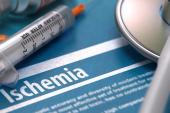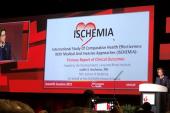ISCHEMIA: PCI/CABG Has Early Hospitalization ‘Tax’ but Equals Meds Later
For the invasive approach, patients spent an additional 6.3 days in the hospital in the first 2 years, but just 2.8 days by 4 years.

Patients with stable ischemic heart disease treated with optimal medical therapy in the ISCHEMIA trial spent more time alive out of the hospital at 2 years when compared with those treated with an invasive strategy, but by 4 years the difference between the two approaches was a wash, according to a new analysis.
When excluding hospitalizations related to the invasive protocol-assigned procedures, there was no statistically significant difference in the number of days spent alive out of hospital (DAOH) between the two treatment strategies at any time point, report investigators.
“DAOH is an important patient-focused metric,” lead investigator Harvey White, DSc (Green Lane Cardiovascular Services/Auckland City Hospital, New Zealand), told TCTMD. “It’s important to measure, as patients value it. Apart from death and a debilitating stroke, patients don’t care that much about endpoints that don’t affect their quality of life. Several studies have shown that patients don’t really want to spend time in hospitals—loss of independence and autonomy, the food, and now risk of getting COVID. They would rather spend time at home with family and friends, in recreation, or even at work.”
The analysis, which was published online May 3, 2021, in JAMA Cardiology, also captured time spent in extended care facilities such as nursing care or rehabilitation facilities. White noted that in a study of frail older patients, the most important health priority they listed was time spent at home. He added that DAOH is easily collected and analyzed and should be part of ongoing or future clinical trials, particularly given its importance when assessing the pros and cons of different procedures or treatments.
Deepak Bhatt, MD (Brigham and Women’s Hospital, Boston, MA), praised the new ISCHEMIA analysis for its rigor, noting that DAOH as a metric is being used more and more in research. It has been used in studies analyzing treatments for patients with stroke and heart failure, for example.
“When we checked with patients, or even those who weren’t patients yet, this was a metric that probably mattered the most to them,” he said, referring to his prior work on Get With The Guidelines. “From a patient’s perspective, they really want to be alive and be at home.”
While mortality is often considered the ultimate endpoint in cardiology and cardiovascular medicine, it’s hard to modify with most contemporary therapies, especially in stable patients, given how well they are treated with background therapies, said Bhatt. While patients want to live longer, they also want to avoid being discharged to a rehab facility or nursing home after a procedure.
Up-front Cost of PCI/CABG
Presented in 2019, the landmark ISCHEMIA trial tested two strategies for the management of stable patients with moderate-to-severe coronary artery disease. An invasive strategy involving PCI or CABG surgery failed to provide any benefit beyond optimal medical therapy alone for reducing the primary composite endpoint of cardiovascular death, MI, hospitalization for unstable angina, hospitalization for heart failure, or resuscitation due to cardiac arrest at 4 years. On the other hand, treatment with PCI/CABG was superior to medical therapy for providing relief from angina.
Explaining the rationale for DAOH, White said time-to-event analyses in studies with composite endpoints give each individual component of that endpoint equal importance, counting events only at the first occurrence. Events of lesser severity occurring early, like hospitalization for unstable angina, would be rated more important than events of greater severity, such as death, which occur later. Additionally, some hospitalizations might not meet trial definitions and wouldn’t be counted in the traditional endpoint-focused trial.
For the 5,179 patients in the randomized trial, researchers analyzed 5,899 total hospital stays. Of these, 4,002 hospital stays were in the invasive management group, with 2,434 stays (60.8%) the result of the invasive protocol-assigned procedure. When hospitalizations related to the index CABG/PCI were excluded, there were fewer stays with invasive management than in the medical-therapy arm (1,568 vs 1,897; P = 0.001).
At 1 month, patients in the medical-therapy arm spent 2.4 more DAOH than those treated invasively (30.8 vs 28.4 days; P < 0.001). At 1 and 2 years, there remained a significant difference in the number of DAOH favoring medical therapy (362.2 vs 355.9 days; P < 0.001; and 718.4 days vs 712.1 days; P = 0.001, respectively), but there was no significant difference between treatments at 4 years.
When the researchers excluded hospitalizations related to the invasive protocol-assigned procedure, there was no difference in the number of days alive out of the hospital between the two treatment strategies at any time point.
Looking at the reasons for the hospitalization, 17.1% of the stays in the invasive group were for cardiovascular causes compared with 57.8% in the medical-therapy arm (P < 0.001). During the 4-year follow-up, there were fewer hospitalizations for spontaneous MIs and unstable angina with the invasive strategy compared with medical therapy alone.
That finding lines up with the original time-to-event analysis published in the New England Journal of Medicine. Although there was no significant difference in the risk of MI between the two strategies at 4 years, there was an early advantage with medical therapy that was followed by a later advantage in favor of PCI/CABG. In ISCHEMIA, the event curves crossed around 2 years, with the data suggesting more spontaneous MIs in the conservative-treatment arm over follow-up.
“The most important thing is to interpret the new DAOH data in the light of the overall ISCHEMIA results where an initial invasive strategy compared to a conservative strategy did not reduce the primary MACE endpoint or all-cause death,” said White. “There were greater improvements in angina-related health status in the patients with angina at baseline and in the present analysis decreased DAOH by 6.3 days per patient at 2 years largely due to assigned procedures in the invasive group. These findings should be incorporated into patient discussions and shared decision-making.”
The new DAOH data, agreed Bhatt, makes it clear to patients there is a trade-off, and while there is an “early price” to pay with PCI/CABG, the reward is that if the patient was having substantial symptoms, based on the ISCHEMIA quality-of-life analysis, there will be an improvement. He also noted that once “the initial tax has been paid” with the invasive approach, the reduction in the hospital stays for unstable angina and spontaneous MI seems quite substantial. Bhatt acknowledged that the MI event rates—1.6% of all hospital stays in the invasive arm versus 6.5% with medical therapy—were quite low in both arms.
“The main reason to be treating this patient population would be because they’re highly symptomatic despite best efforts at optimizing medical therapy,” said Bhatt. “The real goal is to deal with that problem, but the added bonus is that down the road there would be fewer spontaneous MIs and fewer hospitalizations related to it. Overall, I think it buttresses the main ISCHEMIA trial result—lifestyle modification and medical therapy for stable ischemic heart disease remains the first-line approach, but for patients who are symptomatic, days alive out of hospital provides important data to help the physician and patient trying to decide what the next best strategy is, and to give them information.”
One-Third of Stable PCI Patients ‘ISCHEMIA-Like’
A second recent study, presented last week at the virtual Society for Cardiovascular Angiography and Interventions (SCAI) meeting by Saurav Chatterjee, MD (North Shore University Hospital and Long Island Jewish Medical Center, Northwell Health, NY), suggests that a large proportion of real-world patients undergoing PCI for stable ischemic heart disease in the US would not have met the criteria for the ISCHEMIA trial.
Of nearly 390,000 patients with stable ischemic heart disease included in the National Cardiovascular Data Registry, just one-third would have been included in the landmark trial based on the inclusion/exclusion criteria. These were classified as “ISCHEMIA-like” patients, such as those with intermediate- or high-risk findings on stress testing or a positive finding on invasive functional testing.
Another 18.5% were considered high-risk and ineligible for ISCHEMIA, such as those with left main CAD, end-stage renal disease, congestive heart failure, or an ejection fraction < 35%. Finally, 17.3% of patients were considered low-risk and ineligible for ISCHEMIA and 31.9% of patients had insufficient registry information, such as stress test findings, and were deemed unclassifiable.
Compared with the other cohorts, the ISCHEMIA-like patients had the lowest rate of in-hospital mortality (0.1% vs 0.67% and 0.17% in the high- and low-risk patients; P < 0.01) but comparable rates of bleeding. Chatterjee cautioned during a SCAI press conference that the data are observational and subject to limitations, however.
In terms of the implications, Chatterjee told TCTMD the findings show that there are many real-world patients with stable ischemic heart disease who wouldn’t have been eligible for the ISCHEMIA trial, suggesting there might be an opportunity to identify and select excluded patients who would benefit from revascularization.
Michael O’Riordan is the Managing Editor for TCTMD. He completed his undergraduate degrees at Queen’s University in Kingston, ON, and…
Read Full BioSources
White HD, O’Brien SM, Alexander KP, et al. Comparison of days alive out of hospital with initial invasive vs conservative management: a prespecified analysis of the ISCHEMIA trial. JAMA Cardiol. 2021;Epub ahead of print.
Chatterjee S, Fanaroff AC, Parzynski C, et al. Comparison of patients undergoing percutaneous coronary intervention in contemporary US practice to the ISCHEMIA trial population: a National Cardiovascular Data Registry (NCDR) research to practice (R2P) initiative. Presented at: SCAI 2021. April 29, 2021.
Disclosures
- White reports a research grant from the National Heart, Lung, and Blood Institute; grants/fees paid to his institution for serving on the steering committees of trials from Sanofi-Aventis, Regeneron Pharmaceuticals, Eli Lilly and Company, Omthera Pharmaceuticals, American Regent, Eisai, DalCor Pharma, CSL Behring, and Esperion Therapeutics; and personal fees from Genentech and AstraZeneca.





Comments